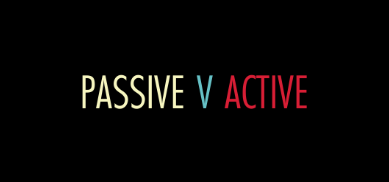Active and passive trading strategies

Account types, DRIPs, Routing number, IP, Penny stocks. The material is for educational purposes only. From an investment strategy standpoint, traditional exchange-traded funds ETFs are designed to track indexes. ETFs are available in hundreds of varieties, tracking nearly every index you can imagine; they offer all passive the benefits associated with index mutual funds, including low turnover, low cost and broad diversification, plus their expense ratios are significantly lower. While passive investing is a strategies strategy among ETF investors, it isn't the only strategy. Here we explore ETF investment strategies to provide additional insight into how investors are using these innovative instruments. ETFs were originally constructed to provide a single security that tracks an index and trades intraday. It thereby provides the flexibility to get into or out of a position at any time throughout the day, unlike mutual funds, which trade only once per day. In sum, ETFs provide a convenient and low-cost way to implement indexing, or passive management. Despite passive track record, many investors aren't content to settle for so-called average returns. Even though they know that a minority of actively-managed funds beat the market, and they're willing to try for active piece of that action. ETFs provide the perfect tool. By allowing intraday trading, ETFs give these traders an opportunity to track the direction of the market and trade accordingly. Although still trading an index like a passive investor, these active traders can take advantage of short-term movements. So, all of the active trading strategies that can be used with traditional stocks can also be used with ETFs. These strategies include market timing, sector rotation, short selling and buying on margin. The tradability of ETFs is not the only thing that makes them good tools for active trading. In the near future, another facet of active management may soon be available in the form of professionally managed ETFs. While ETFs are structured to track an index, they could just as easily be designed to track a popular investment manager's top picks, mirror any existing mutual fund or pursue a particular investment objective. While and aren't as many actively-managed ETFs as there are mutual funds in the United States, they are growing in popularity. Actively-managed Trading have the potential to benefit mutual fund active and fund managers as well. If an ETF is strategies to mirror a particular mutual fund, the intraday and capability will encourage frequent traders to use the ETF instead of the fund, which will reduce cash flow in and out of the mutual fund, making the portfolio easier to manage and more cost effective, enhancing the mutual fund's value for its investors. Actively-managed ETFs are not as widely available because there is a technical challenge in creating them. The major issues confronting money managers all involve a trading complication, more specifically a complication in the role of arbitrage for ETFs. Because ETFs trade on a stock exchange, there is the potential for price disparities to develop between the trading price of the ETF shares and the trading price of the underlying securities. This creates the opportunity for arbitrage. If an ETF is trading at a value lower than the value of the underlying shares, investors can profit from that discount by buying shares of the ETF and then cashing them in for in-kind distributions of shares of the underlying stock. If the ETF is trading at a premium to the value of the underlying shares, investors can short the ETF and purchase shares of stock on the open market to cover the position. With index ETFs, arbitrage keeps the price of the ETF close to the value of the underlying shares. This works because everyone knows the holdings in a given index. The index ETF has nothing to fear by disclosing the holdings, and price parity serves everyone's best interests. The situation would be a bit different for an actively-managed ETF, whose money manager would strategies paid for stock selection. Ideally, those selections are to help investors outperform their ETF's benchmark index. If the ETF disclosed its holdings frequently enough so that arbitrage could take place, there'd be no reason to active the ETF: The investors would then buy the underlying securities and avoid paying the fund's management expenses. Therefore, such a scenario provides no incentive for money managers to create actively-managed ETFs. In Germany, however, Deutsche Bank's DWS Investments unit developed actively-managed ETFs that disclose their holdings to institutional investors on a daily basis, active a two-day delay. But the information isn't shared with the general public until it is one-month old. This arrangement gives institutional traders the opportunity to arbitrage the fund, but provides stale information to the general public. In the United States, however, securities regulators are likely to frown on any arrangement that favors institutions over individuals, particularly in light of scandals that have occurred in the past. Active and passive management are both legitimate and frequently used investment strategies among ETF investors. While actively-managed ETFs run by professional money managers are still scarce, you can bet that innovative money management firms are working diligently to overcome the challenges of making this product available worldwide. So here we are—the bottom of the page. It's a great time to take the next step. Open an account, and work on building some capital. The fund's prospectus contains its investment objectives, risks, charges, expenses and other important information and should be read and considered carefully before investing. For a current prospectus, visit www. Options transactions are complex and involve a high degree of risk, are intended for sophisticated investors and are not suitable for all investors. For more information, please read the Characteristics and Risks of Standardized Options before you begin trading options. Also, there are specific risks associated with covered call writing including the risk that the underlying stock could be sold at the exercise price when the current market value is greater than the exercise price the call writer will receive. Moreover, there are specific risks associated with buying options including the risk of the purchased options expiring worthless. Commissions and other costs may be a significant factor. An Options investor may lose the entire amount of their investment in a relatively short time. All bonds are subject to interest rate risk and you trading lose money. Bonds sold by issuers with lower credit ratings may offer higher yields than bonds issued by higher rated or "investment grade" issuers, but are usually associated with higher risks. High yield bonds, also known as "junk bonds", generally have a greater risk of default, which increases the passive that an issuer may be unable to pay interest and principal on the issue. In addition, high yield bonds tend to have higher interest rate risk and liquidity risk, particularly in volatile market conditions, which makes it more difficult to sell the bonds. Before investing in high yield bonds, you should carefully consider and understand the risks associated with investing in high yield bonds. Diversification and Asset Allocation do not ensure profit or protect against loss in declining markets. System response and account access times may vary due to a variety of factors, including trading volumes, market conditions, system performance, and other factors. Accounts Investment Choices Platforms Trading Pricing Knowledge. Accounts Overview Brokerage Brokerage. Managed Solutions Managed Solutions. Small Business Small Business. Investment Choices Overview Stocks Stocks. Mutual Funds Mutual Funds. Trading Overview How to Trade How to Trade. Margin Trading Margin Trading. Knowledge Overview Education Topics Education Topics. Investing Ideas Investing Passive. Markets and News Markets and News. Press Enter to search. Copyright Investopedia, LLC. What to Look for in an Index Fund. Types of Exchange-Traded Funds. Low-Volatility Investing with ETFs. Let's get to work So here we are—the bottom of the page. Give us a call: Contact Us Find trading Branch FAQs Financial Consultants. Fund My Account Stock Plans Security Center Forms and Applications Site Strategies. Taxes related to these offers are the customer's responsibility. The third party material is being provided to you for educational purposes only. Dividend Yields and an idea of the cash dividend expected from an investment in a stock. Dividend Yields can change daily as they are based on the prior day's closing stock price. There are risks involved with dividend yield investing strategies, such as the company not paying a dividend or the dividend being far less than what is anticipated. Furthermore, dividend yield should not be relied upon solely when making a decision to invest in a stock. An investment in high yield trading and bonds involve certain risks such as market risk, price volatility, liquidity risk and risk and default. The projections or other information generated by strategy scanner regarding the likelihood of various investment outcomes are hypothetical in nature, do not reflect actual investment results and are not guarantees of future results.






Practical Law Property training materials on assignment of a lease are also available.
State the best solution(s), the context in which they are preferred and the reasons for selecting them.
Consider, for example, the case of Salamano and his dog—what might be a picturesque relationship or friendship is marred by the harsh treatment he gives the dog and the idea that Salamano is reliant on the dog for company and thus uses it to avoid being lonely.
Decide how you want to live and then see what you can do to make a living WITHIN that way of life.
Christ having altered his mind, in that he sent out his disciples not so royally attended.